Using Historical Maps within a GIS to Analyze Two Centuries of Rural Landscape Changes in Southern Italy
Abstract
:1. Introduction
2. Materials and Methods
2.1. Study Area
2.2. Cartography
2.3. Historical Documents
2.4. Data Analysis
2.4.1. Georeferencing and Data Processing
- natural land: includes forest (according to FAO definition) and transitional woodland-shrubs, an afforested land with conifers realized in the 1960s, transitional woodland-shrubs area (containing shrub or herbaceous vegetation with scattered trees and vegetation formations that may result from the degradation of the forest or a regeneration of the same for re-colonisation of non-forest areas);
- agricultural land: includes all types of cultivated areas, i.e., arable lands, vineyards, olive groves, permanent crops like orchards, permanent and natural pastures, natural pastures with spontaneous herbaceous vegetation, etc.;
- urbanized area: includes new and old farms, buildings and artificial surfaces next to farms. This category also includes infrastructure to regulate water flow;
- road network: includes only roads involving a significant surface and with an important traffic flow. Provincial and municipal roads are included, whilst all typologies of minor rural roads are not included; and
- river: includes the area corresponding to the bed of the Bradano river and the vegetation present along the river.
2.4.2. DTM and Three-Dimensional Modelling
2.4.3. Methods for Map Comparison and Correlation Analysis
3. Results
3.1. Land Use
3.2. Infrastructure
3.3. Landscape
4. Discussion
5. Conclusions
Author Contributions
Conflicts of Interest
References
- Rescia, A.J.; Willaarts, A.B.; Schmitz, M.F.; Aguilera, P.A. Changes in land uses and management in two Nature Reserves in Spain: Evaluating the social-ecological resilience of cultural landscapes. Landsc. Urban Plan. 2010, 98, 26–35. [Google Scholar] [CrossRef]
- Statuto, D.; Tortora, A.; Picuno, P. Spatial modeling and image processing of historical maps for rural landscape planning. In Proceedings of the International Conference of Agricultural Engineering-EurAgEng 2014, Zurich, Switzerland, 6–10 July 2014. [Google Scholar]
- Pelorosso, R.; Leone, A.; Boccia, L. Land cover and land use change in the Italian central Apennines: A comparison of assessment methods. Appl. Geogr. 2009, 29, 35–48. [Google Scholar] [CrossRef]
- Schneeberger, N.; Bürgi, M.; Kienast, P.D.F. Rates of landscape change at the northern fringe of the Swiss Alps: Historical and recent tendencies. Landsc. Urban Plan. 2007, 80, 127–136. [Google Scholar] [CrossRef]
- Yeh, C.T.; Huang, S.L. Investigating spatiotemporal patterns of landscape diversity in response to urbanization. Landsc. Urban Plan. 2009, 93, 151–162. [Google Scholar] [CrossRef]
- Statuto, D.; Tortora, A.; Picuno, P. Analysis of the evolution of landscape and land use in a GIS approach. In Proceedings of the First International Symposium Article on Agricultural Engineering—ISAE 2013, Session VI, Belgrade, Serbia, 4–6 October 2013; pp. 25–33. [Google Scholar]
- Mutoko, M.C.; Hein, L.; Bartholomeus, H. Integrated analysis of land use changes and their impacts on agrarian livelihoods in the western highlands of Kenya. Agric. Syst. 2014, 128, 1–12. [Google Scholar] [CrossRef]
- Tveit, M.; Ode, A.; Fry, G. Key visual concepts in a framework for analyzing visual landscape character. Landsc. Res. 2006, 31, 229–255. [Google Scholar] [CrossRef]
- Franch-Pardo, I.; Cancer-Pomar, L.; Napoletano, B.M. Visibility analysis and landscape evaluation in Martin river cultural park (Aragon, Spain) integrating biophysical and visual units. J. Maps 2017, 2, 415–424. [Google Scholar] [CrossRef]
- Domon, G. Landscape as resource: Consequences, challenges and opportunities for rural development. Landsc. Urban Plan. 2011, 100, 338–340. [Google Scholar] [CrossRef]
- Ales, R.F.; Martin, A.; Ortega, F.; Ales, E. Recent changes in landscape structure and function in a Mediterranean region of SW Spain (1950–1984). Landsc. Ecol. 1992, 7, 3–18. [Google Scholar] [CrossRef]
- García-Ruiz, J.M.; Lasanta, T.; Ruiz-Flano, P.; Ortigosa, L.; White, S.; Gonzales, C.; Martì, C. Land-use changes and sustainable development in mountain areas: A case study in the Spanish Pyrenees. Landsc. Ecol. 1996, 11, 267–277. [Google Scholar] [CrossRef]
- Debussche, M.; Lepart, J.; Dervieux, A. Mediterranean landscape changes: Evidence from old postcards. Glob. Ecol. Biogeogr. 1999, 8, 3–15. [Google Scholar] [CrossRef]
- MacDonald, D.; Crabtree, J.R.; Wiesinger, G.; Dax, T.; Stamou, N.; Fleury, P.; GutierrexLazpita, J.; Gibon, A. Agriculture abandonment in mountain areas of Europe: Environmental consequences and policy response. J. Environ. Manag. 2000, 59, 47–69. [Google Scholar] [CrossRef]
- Santos, C.P. Succession of breeding bird communities after the abandonment of agricultural fields in southeast, Portugal. Ardeola 2000, 47, 171–181. [Google Scholar]
- Lambin, E.F.; Geist, H.J.; Lepers, E. Dynamics of land use and land cover change in tropical regions. Annu. Rev. Environ. Resour. 2003, 28, 205–241. [Google Scholar] [CrossRef]
- Covas, R.; Blondel, J. Biogeography and history of the Mediterranean bird fauna. Ibis 1998, 140, 395–407. [Google Scholar] [CrossRef]
- Picuno, P.; Tortora, A.; Capobianco, R.L. Analysis of plasticulture landscapes in Southern Italy through remote sensing and solid modelling. Landsc. Urban Plan. 2011, 100, 45–56. [Google Scholar] [CrossRef]
- Statuto, D.; Tortora, A.; Picuno, P. A GIS approach for the quantification of forest and agricultural biomass in the Basilicata region. J. Agric. Eng. 2013, XLIV, 627–631. [Google Scholar] [CrossRef]
- Statuto, D.; Picuno, P. Valorisation of vernacular farm buildings for the sustainable development of rural tourism in mountain areas of the Adriatic-Ionian macro-region. J. Agric. Eng. 2017, 48, 21–26. [Google Scholar] [CrossRef]
- De Philippis, A. Classificazione ed Indici del Clima in Rapporto Alla Vegetazione Forestale Italiana; Società Botanica Italiana: Firenze, Italy, 1937. [Google Scholar]
- Blakemore, M.J.; Harley, J.B. Concepts in the history of cartography. A review and perspective. Cartographica 1980, 17, 1–120. [Google Scholar]
- Laxton, P. The Geodetic and topographical evaluation of English county maps, 1740–1840. Cartogr. J. 1976, 13, 37–54. [Google Scholar] [CrossRef]
- Jenny, B.; Hurni, L. Studying cartographic heritage: Analysis and visualization of geometric distortions. Comput. Graph. 2011, 35, 402–411. [Google Scholar] [CrossRef]
- Tortora, A.; Statuto, D.; Picuno, P. Rural landscape planning through spatial modelling and image processing of historical maps. Land Use Policy 2015, 42, 71–82. [Google Scholar] [CrossRef]
- Yang, Y.; Zhang, S.; Yang, J. A review of historical reconstruction methods of land use/land cover. J. Geogr. Sci. 2014, 24, 746–766. [Google Scholar] [CrossRef]
- De Marco, D. La Statistica Del Regno Di Napoli Nel 1811—Volume III (1900); Accademia Naz. dei Lincei: Rome, Italy, 1990; pp. 24–25, 54–59, 228–233, 474–477. [Google Scholar]
- Forenza Municipality. Relazione Sulle Usurpazioni Del Bosco Demaniale Di San Giuliano; Stab. Tipografico “Fulgur”: Potenza, Italy, 1915. [Google Scholar]
- Lafreniere, D.; Rivet, D. Rescaling the Past through Mosaic Historical Cartography. J. Maps 2010, 6, 417–422. [Google Scholar] [CrossRef]
- Boùùaert, M.C.; De Baets, B.; Vervust, S.; Neutens, T.; De Maeyer, P.; Van de Weghe, N. Computation and visualisation of the accuracy of old maps using differential distortion analysis. Int. J. Geogr. Inf. Sci. 2016, 30, 1225–1280. [Google Scholar]
- Statuto, D.; Cillis, G.; Picuno, P. Analysis of the effects of agricultural land use change on rural environment and landscape through historical cartography and GIS tools. J. Agric. Eng. 2016, 47, 28. [Google Scholar] [CrossRef]
- Lautenbach, S.; Kugel, C.; Lausch, A.; Seppelt, R. Analysis of historic changes in regional ecosystem service provisioning using land use data. Ecol. Indic. 2011, 11, 676–687. [Google Scholar] [CrossRef]
- Kosztra, B.; Arnold, S. Proposal for Enhancement of CLC Nomenclature Guidelines; ETC/SIA Deliverable EEA Subvention 2013 WAI Task 261_1_1: Applying EAGLE Concept to CLC Guidelines Enhancement. European Environment Agency Internal Report; EEA-European Environment Agency: Copenhagen, Denmark, 2013. [Google Scholar]
- Kakiuchi, T.; Chikatsu, H. Reconstruction and visualization of original landscape on reverse mapping. Int. Arch. Photogram. Remote Sens. Spat. Inf. Sci. 2010, 38, 311–315. [Google Scholar]
- Picuno, P. Vernacular farm buildings in landscape planning: A typological analysis in a southern Italian region. J. Agric. Eng. 2012, 43, 130–137. [Google Scholar] [CrossRef]
- Italian Regulations for the Expropriation, Land Reclamation, Processing and Allocation of the Peasants’s Land. G.U. No. 249, 28/10/1950. Law of October 21, No. 841. 1950. Available online: http://www.edizionieuropee.it/LAW/HTML/10/zn2_02_033.html (accessed on 18 September 2017).
- Commission Regulation EEC No. 1272/88 Laying Down Detailed Rules for Applying the Set-Aside Incentive Scheme for Arable Land. Available online: http://research.omicsgroup.org/index.php/Set-aside (accessed on 18 September 2017).
- Van Vliet, J.; de Groot, H.L.F.; Rietveld, P.; Verburg, P.H. Manifestations and underlying drivers of agricultural land use change in Europe. Landsc. Urban Plan. 2015, 133, 24–36. [Google Scholar] [CrossRef]
- Gutzler, C.; Helming, K.; Balla, D.; Dannowski, R.; Deumlich, D.; Glemnitz, M.; Knierim, A.; Mirschel, W.; Nendel, C.; Paul, C.; et al. Agricultural land use changes—A scenario-based sustainability impact assessment for Brandenburg, Germany. Ecol. Indic. 2015, 48, 505–517. [Google Scholar] [CrossRef]
- Geri, F.; Amici, V.; Rocchini, D. Human activity impact on the heterogeneity of a Mediterranean landscape. Appl. Geogr. 2010, 30, 370–379. [Google Scholar] [CrossRef]
- Blondel, J. The ‘design’ of Mediterranean landscapes: A millennial story of humans and ecological systems during the historic period. Hum. Ecol. 2006, 34, 713–729. [Google Scholar] [CrossRef]
- Rühl, J.; Pasta, S.; La Mantia, T. Metodologia per lo studio delle successioni secondarie in ex-coltivi terrazzati: Il Caso studio di Pantelleria (Canale di Sicilia). For. J. Silvic. For. Ecol. 2005, 2, 388–398. [Google Scholar] [CrossRef]
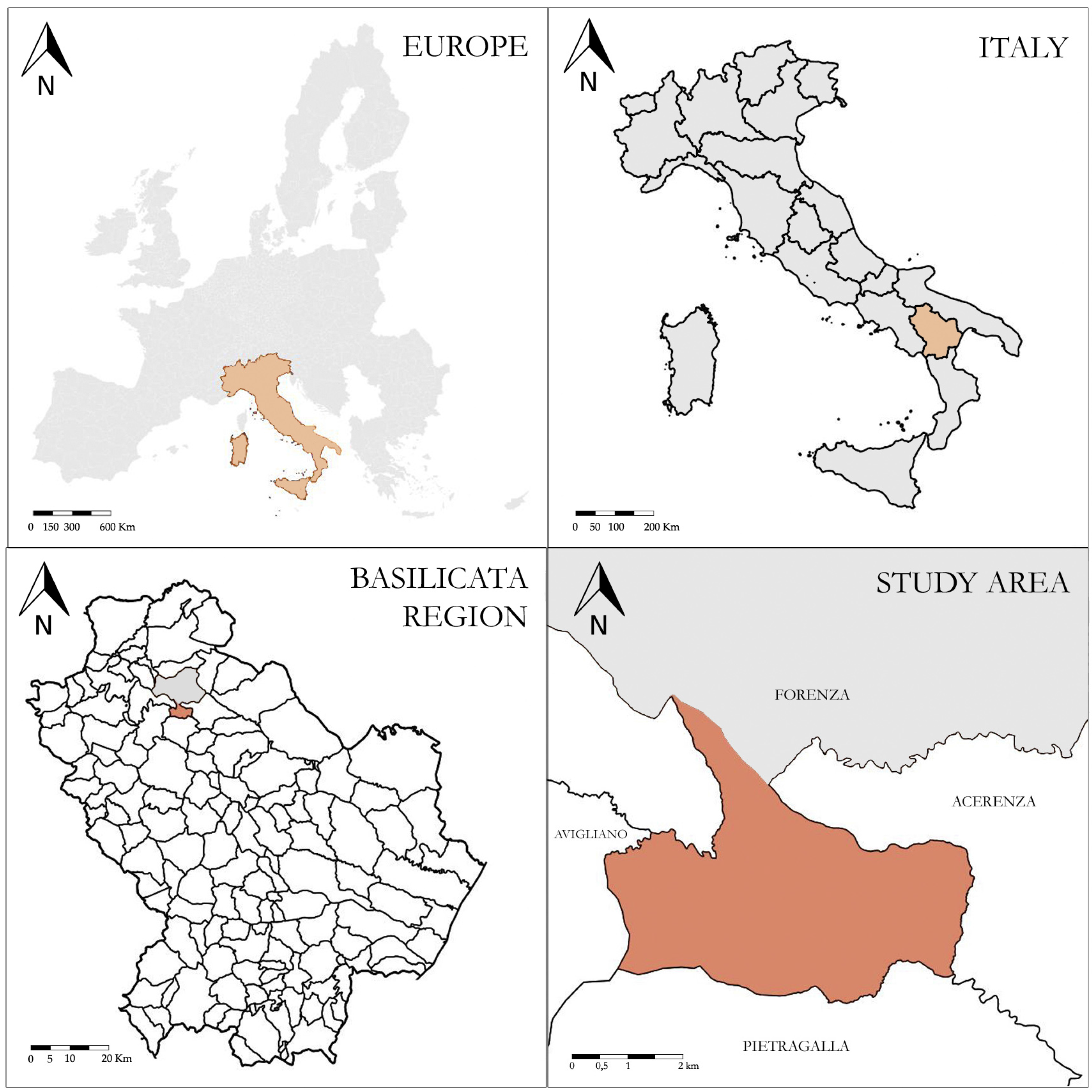

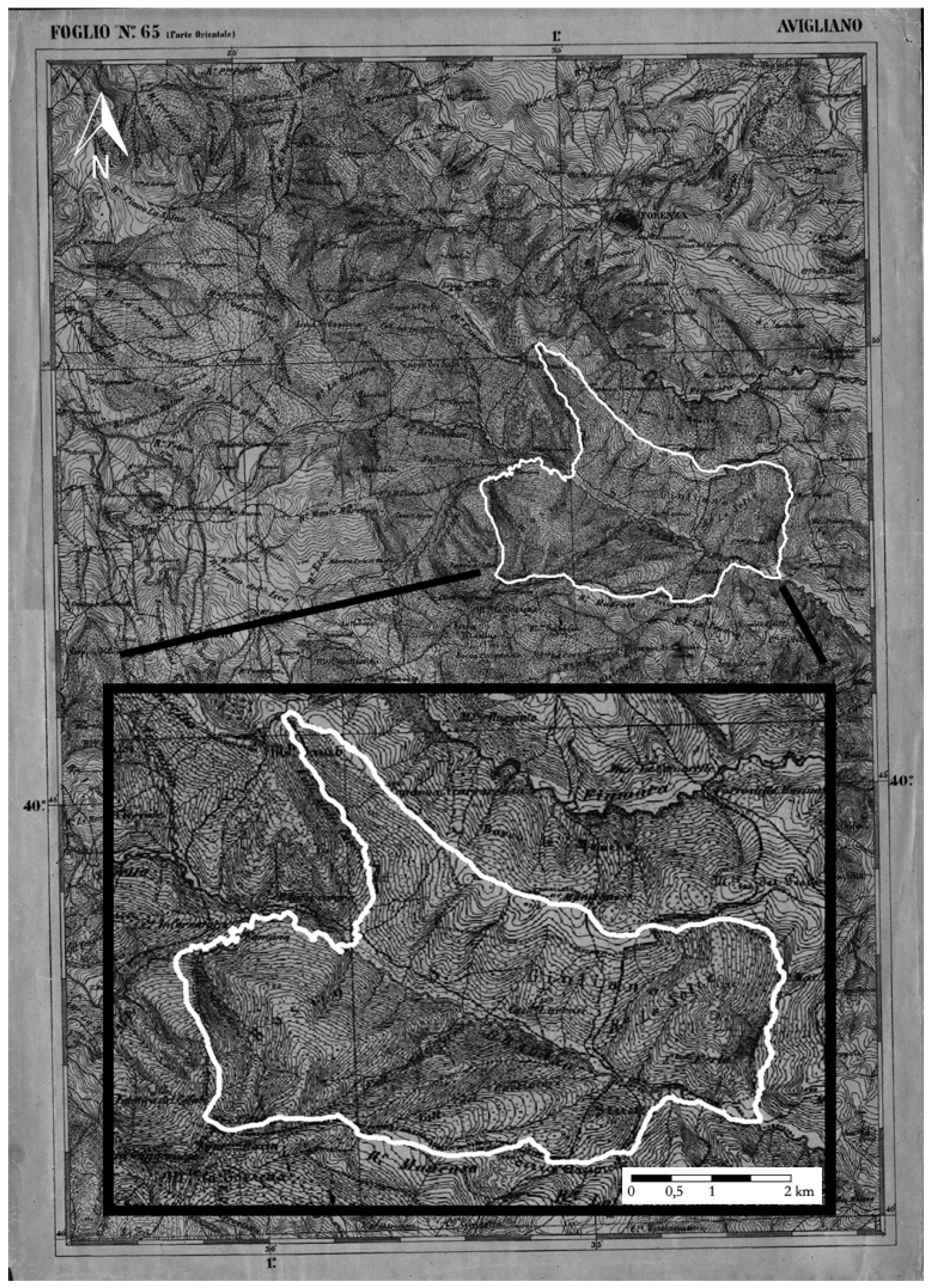

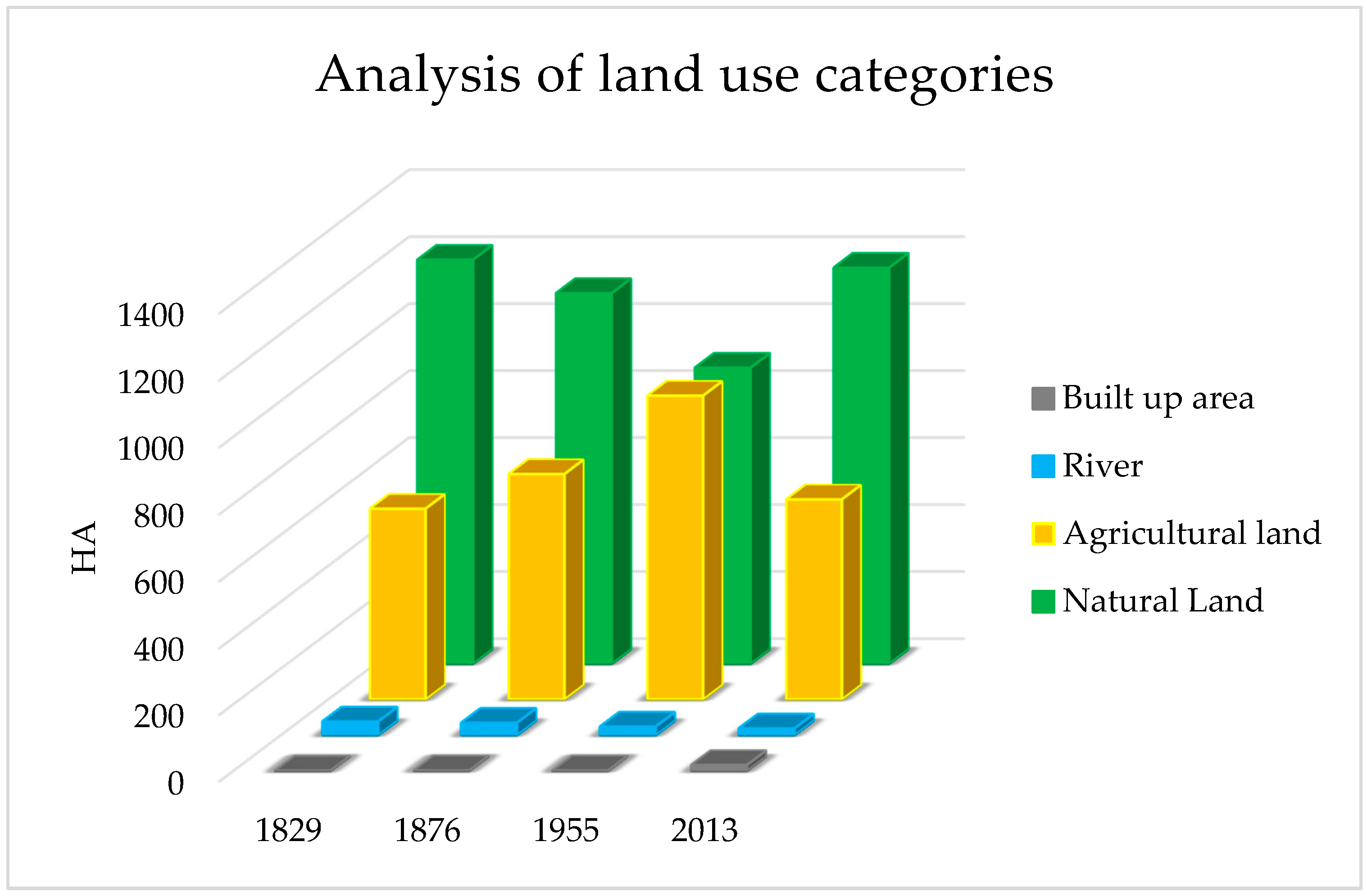
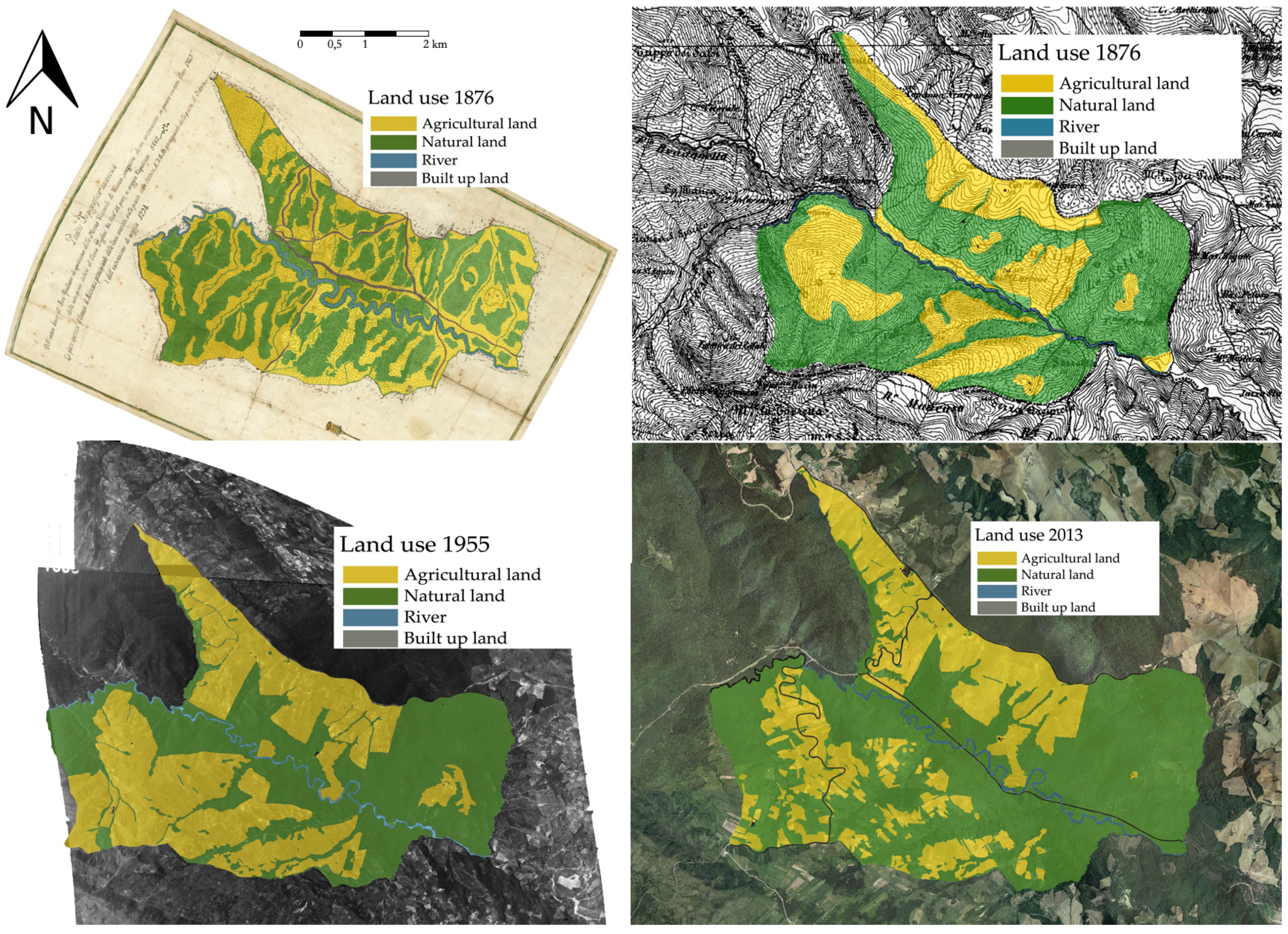
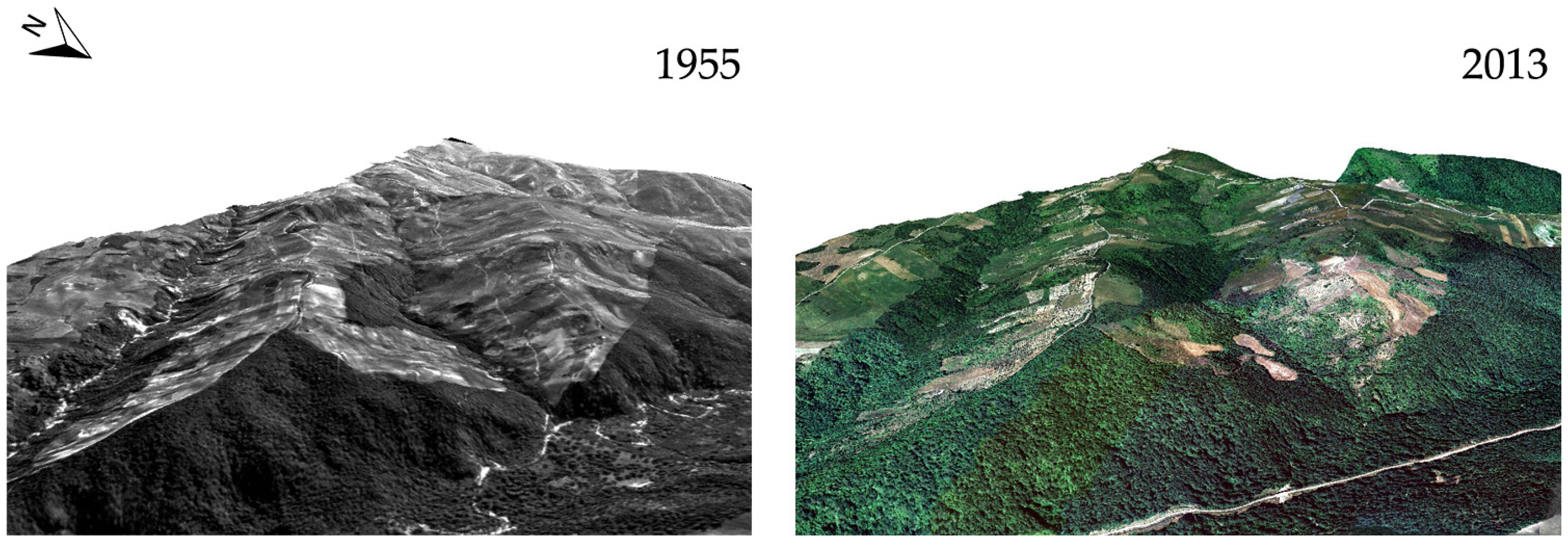
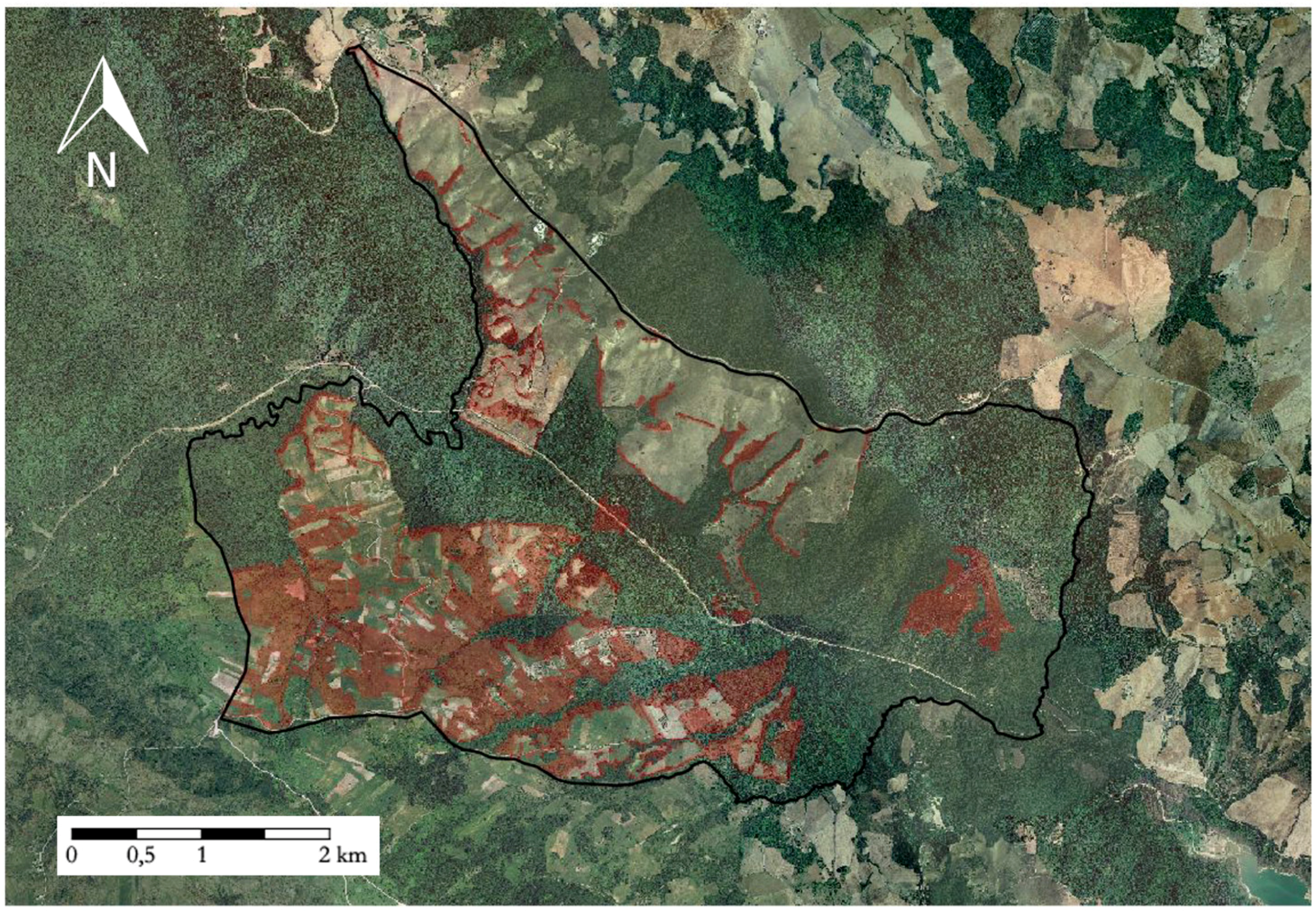
| Land Use Categories | Years | |||||||
|---|---|---|---|---|---|---|---|---|
| 1829 | 1876 | 1955 | 2013 | |||||
| ha | % | ha | % | ha | % | ha | % | |
| Natural Land | 1206.15 | 66.3 | 1106.55 | 60.9 | 883.94 | 48.6 | 1182.51 | 65.0 |
| Agricultural land | 570.3 | 31.4 | 673.60 | 37.0 | 907.84 | 49.9 | 598.04 | 32.9 |
| River | 40.9 | 2.2 | 36.90 | 2.0 | 25.30 | 1.4 | 19.96 | 1.1 |
| Built up area | 0.8 | 0.0 | 1.10 | 0.1 | 1.07 | 0.1 | 17.64 | 1.0 |
| Total | 1818.15 | 100 | 1818.15 | 100 | 1818.15 | 100 | 1818.15 | 100 |
| Categories | ||
|---|---|---|
| Years | Road Network (meters) | Building Number (n) |
| 1829 | 22,736 | 13 |
| 1876 | 29,162 | 18 |
| 1955 | 63,862 | 38 |
| 2013 | 69,129 | 55 |
© 2017 by the authors. Licensee MDPI, Basel, Switzerland. This article is an open access article distributed under the terms and conditions of the Creative Commons Attribution (CC BY) license (http://creativecommons.org/licenses/by/4.0/).
Share and Cite
Statuto, D.; Cillis, G.; Picuno, P. Using Historical Maps within a GIS to Analyze Two Centuries of Rural Landscape Changes in Southern Italy. Land 2017, 6, 65. https://0-doi-org.brum.beds.ac.uk/10.3390/land6030065
Statuto D, Cillis G, Picuno P. Using Historical Maps within a GIS to Analyze Two Centuries of Rural Landscape Changes in Southern Italy. Land. 2017; 6(3):65. https://0-doi-org.brum.beds.ac.uk/10.3390/land6030065
Chicago/Turabian StyleStatuto, Dina, Giuseppe Cillis, and Pietro Picuno. 2017. "Using Historical Maps within a GIS to Analyze Two Centuries of Rural Landscape Changes in Southern Italy" Land 6, no. 3: 65. https://0-doi-org.brum.beds.ac.uk/10.3390/land6030065






